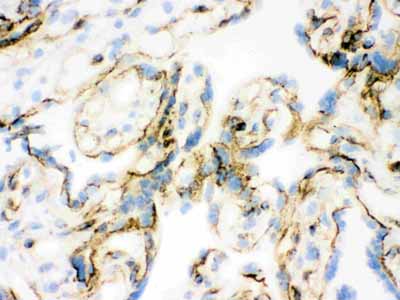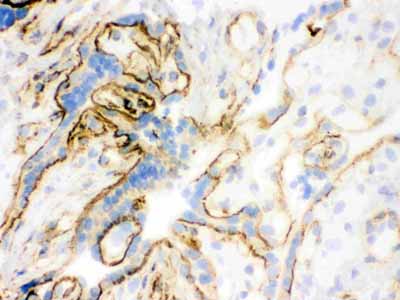Application 
| WB, IHC-F |
|---|---|
| Primary Accession | P85972 |
| Host | Mouse |
| Isotype | Mouse IgG1 |
| Reactivity | Human, Mouse, Rat |
| Clonality | Monoclonal |
| Format | Lyophilized |
| Description | Mouse IgG monoclonal antibody for Vinculin, vinculin (VCL) detection. Tested with WB, IHC-F in Human;mouse;rat;chicken. No cross reactivity with other proteins. |
| Reconstitution | Add 1ml of PBS buffer will yield a concentration of 100ug/ml. |
| Gene ID | 305679 |
|---|---|
| Other Names | Vinculin, Vcl {ECO:0000250|UniProtKB:P18206} |
| Calculated MW | 116615 MW KDa |
| Application Details | Immunohistochemistry(Frozen Section), 2-4 µg/ml, Human, chicken, mouse, rat, - Western blot, 1-2 µg/ml, Human, chicken, mouse, rat |
| Subcellular Localization | Cell membrane ; Peripheral membrane protein ; Cytoplasmic side . Cell junction, adherens junction . Cell junction, focal adhesion . Cytoplasm, cytoskeleton . Recruitment to cell-cell junctions occurs in a myosin II-dependent manner. Interaction with CTNNB1 is necessary for its localization to the cell-cell junctions. . |
| Tissue Specificity | VCL: Metavinculin is muscle-specific. |
| Protein Name | Vinculin |
| Contents | Mouse ascites fluid, 1.2% sodium acetate, 2mg BSA, with 0.01mg NaN3 as preservative. |
| Clone Names | hVIN-1 |
| Immunogen | Human vinculin, purified from uterus. |
| Purification | Ascites |
| Cross Reactivity | No cross reactivity with other proteins |
| Storage | At -20˚C for one year. After r˚Constitution, at 4˚C for one month. It˚Can also be aliquotted and stored frozen at -20˚C for a longer time.Avoid repeated freezing and thawing. |
| Sequence Similarities | Belongs to the vinculin/alpha-catenin family. |
| Name | Vcl {ECO:0000250|UniProtKB:P18206} |
|---|---|
| Function | Actin filament (F-actin)-binding protein involved in cell- matrix adhesion and cell-cell adhesion. Regulates cell-surface E- cadherin expression and potentiates mechanosensing by the E-cadherin complex. May also play important roles in cell morphology and locomotion. |
| Cellular Location | Cell membrane {ECO:0000250|UniProtKB:P12003}; Peripheral membrane protein {ECO:0000250|UniProtKB:P12003}; Cytoplasmic side {ECO:0000250|UniProtKB:P12003}. Cell junction, adherens junction {ECO:0000250|UniProtKB:P12003}. Cell junction, focal adhesion {ECO:0000250|UniProtKB:P12003}. Cytoplasm, cytoskeleton. Cell membrane, sarcolemma {ECO:0000250|UniProtKB:Q64727}; Peripheral membrane protein {ECO:0000250|UniProtKB:Q64727}; Cytoplasmic side {ECO:0000250|UniProtKB:Q64727}. Cell projection, podosome {ECO:0000250|UniProtKB:Q64727}. Note=Recruitment to cell-cell junctions occurs in a myosin II-dependent manner. Interaction with CTNNB1 is necessary for its localization to the cell-cell junctions {ECO:0000250|UniProtKB:P12003} |

Thousands of laboratories across the world have published research that depended on the performance of antibodies from Abcepta to advance their research. Check out links to articles that cite our products in major peer-reviewed journals, organized by research category.
info@clinisciences.com, and receive a free "I Love Antibodies" mug.
Provided below are standard protocols that you may find useful for product applications.
Background
Vinculin is a cytoskeletal protein associated with the cytoplasmic face of both cell-cell and cell-extracellular matrix adherens-type junctions, where it is thought to function as one of several interacting proteins involved in anchoring F-actin to the membrane. Both human and chicken embryo sequences of vinculin contain 1,066 amino acids and, furthermore, that the 2 proteins exhibit a high level of sequence identity(greater than 95%). Vinculinis mapped to 10q22.1-q23.








